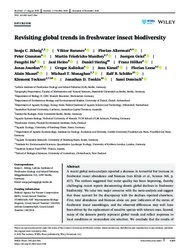Revisiting global trends in freshwater insect biodiversity
Friedrichs‐Manthey, Martin
Hering, Daniel
Jähnig, Sonja C.; Baranov, Viktor; Altermatt, Florian; Cranston, Peter; Friedrichs‐Manthey, Martin; Geist, Juergen; He, Fengzhi; Heino, Jani; Hering, Daniel; Hölker, Franz; Jourdan, Jonas; Kalinkat, Gregor; Kiesel, Jens; Leese, Florian; Maasri, Alain; Monaghan, Michael T.; Schäfer, Ralf B.; Tockner, Klement; Tonkin, Jonathan D.; Domisch, Sami, 2020: Revisiting global trends in freshwater insect biodiversity. In: Wiley Interdisciplinary Reviews: Water, Band 8, 2, DOI: 10.23689/fidgeo-4032.
 |
Dokument öffnen: |
A recent global meta‐analysis reported a decrease in terrestrial but increase in freshwater insect abundance and biomass (van Klink et al., Science 368, p. 417). The authors suggested that water quality has been improving, thereby challenging recent reports documenting drastic global declines in freshwater biodiversity. We raise two major concerns with the meta‐analysis and suggest that these account for the discrepancy with the declines reported elsewhere. First, total abundance and biomass alone are poor indicators of the status of freshwater insect assemblages, and the observed differences may well have been driven by the replacement of sensitive species with tolerant ones. Second, many of the datasets poorly represent global trends and reflect responses to local conditions or nonrandom site selection. We conclude that the results of the meta‐analysis should not be considered indicative of an overall improvement in the condition of freshwater ecosystems.
This article is categorized under:
Water and Life > Conservation, Management, and Awareness Relying on abundance or biomass and examining nonrepresentative datasets limits our ability to infer the condition of freshwater insect communities globally. Photo by Jeremy Monroe, Freshwaters Illustrated: a caddisfly larva from an Oregon Coastal stream, USA (Limnephilidae: Dicosmoecus sp.).
Statistik:
ZugriffsstatistikSammlung:
This is an open access article under the terms of the Creative Commons Attribution License, which permits use, distribution and reproduction in any medium, provided the original work is properly cited.

